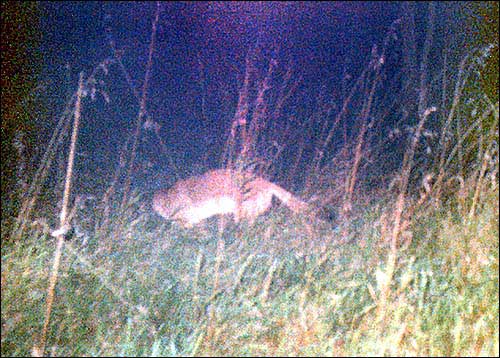Experts skeptical about mountain lion photo
They won’t say it’s a mountain lion. And they won’t say it isn’t.
Three Kansas experts who have studied mountain lions have been examining a photo taken Oct.1 on Kansas University’s west campus by a KU faculty member with an automatic motion-detector camera.
“It’s inconclusive to me. I can’t say that it is a mountain lion or is not. It’s just not distinct enough,” said Charlie Lee, extension wildlife specialist at K-State Research and Extension at Kansas State University in Manhattan.
Others who have looked at it are Philip Gipson, leader of the Kansas Cooperative Fish and Wildlife Research Unit at K-State, and Matt Peek, a Wildlife and Parks research biologist who works out of Emporia. Both had similar opinions.
“I don’t see anything that can make me 100 percent certain that it is a cougar. And by the same token, I don’t see anything that indicates that it is not a cougar,” Peek said.
Gipson said the animal appeared to be too small to be a cougar and could possibly be a fox — except the tail doesn’t seem bushy enough.
The person who took the photo, Mark Jakubauskas, a research assistant professor in the Kansas Applied Remote Sensing Program of the Kansas Biological Survey, said he heard from others Wednesday who said they had seen a mountain lion in the area.
Jakubauskas said he would continue working with his camera, “hoping to get that trophy shot.”
Chasing shadows

An animal can be seen in this patch of grass on Kansas University's west campus. The photo, whose owner believes depicts a mountain lion, was taken last week by a motion detection-triggered wildlife camera.
Lee has been looking for the definitive shot for a long time. He has been investigating cougar reports since 1986.
He said he received one to two reports of mountain lions per week. He treats all as if they were credible.
“I have not found what I call scientific evidence. I would like a clear photo, a good track, or a plaster cast or a picture, or hair, or an animal,” Lee said.
The photo of the animal on KU’s west campus appears to have much longer hair and appears to be too well-fed to be a mountain lion, he said.
Fox or a cat
Lee showed the photo to Gipson, who showed it to a K-State class studying exotic animals that are making a comeback.
 See a See a |
“I had the whole class look at these photographs,” he said, referring to the main photograph and a cropped, enhanced version.
“It’s a fascinating photograph,” Gipson said. “The truth is, it simply lacks enough detail to give you a firm opinion as to what it is.”
Some of the students pointed out that in comparison with the grass in front of it, the animal would seem to be too small — less than knee-high, Gipson said.
“That would be fairly small, even for a female cougar,” he said.
There is a possibility it could be a very large domestic cat, but the argument against that is coloration, he said.
Red foxes are commonly found in such areas, but a fox’s tail would be bushier, Gipson said.
He ruled out a dog. The animal appears to be pursuing something and a dog’s tail would be high in pursuit, he said.
Gipson suggested that someone bring a well-trained cougar-hunting dog to the area on a leash to see if the dog showed interest.
Cougar-like features
Peek, a furbearing mammal expert for Wildlife and Parks, said the photo just doesn’t provide him with enough information to make a good call.
Peek said some who have seen the photo have said it might be a grey fox or a coyote.
“To me, it has more characteristics of a cougar than anything else,” he said.
He said there is a possibility it could be a dog, such as a yellow lab.
“I noticed the curved rump. That looked a little bit odd to me,” Peek said.
Big-cat food
Gipson said a cougar could probably support itself in an area with a number of small animals. The area on west campus is fairly wooded with a creek and a pond nearby.
Adult females could live off of four pounds of meat per day, with males needing more, he said.
“Two or three squirrels, a cottontail or a house cat and it would sustain itself or an occasional white-tailed deer,” Gipson said.
Peek and Chad Luce, public information officer for Wildlife and Parks, said their department does not deny that mountain lions live in Kansas. They have just never found conclusive proof.
“We have not claimed that they are not here,” Peek said. “We don’t have a specimen that they are.”
Peek said every state around Kansas has been able to find evidence of mountain lions.
“To some degree it would be foolish to deny one would not show up in Kansas,” Peek said.







